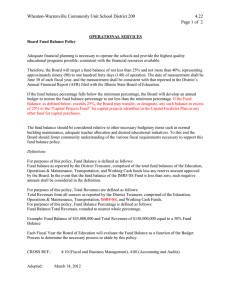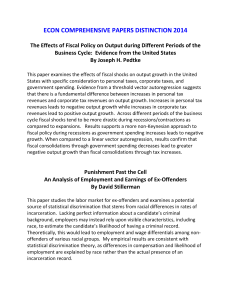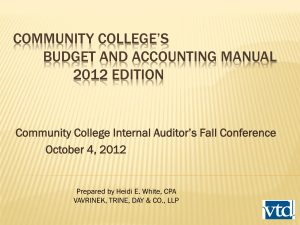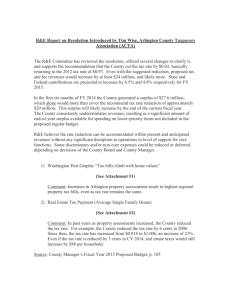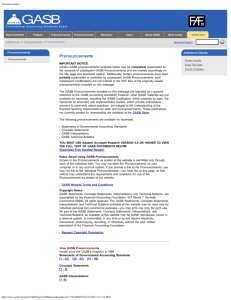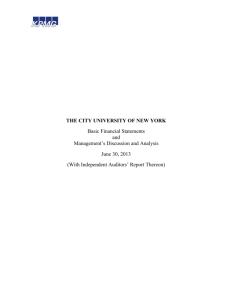945 - North Carolina State Treasurer
advertisement
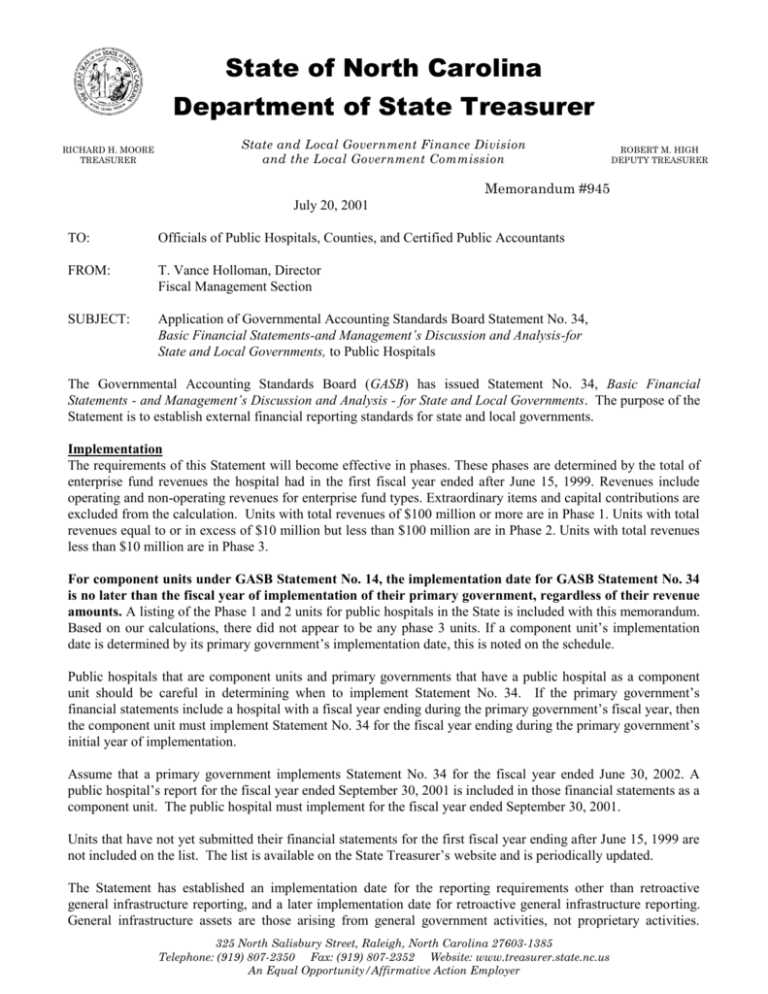
State of North Carolina Department of State Treasurer RICHARD H. MOORE TREASURER State and Local Government Finance Division and the Local Government Commission ROBERT M. HIGH DEPUTY TREASURER Memorandum #945 July 20, 2001 TO: Officials of Public Hospitals, Counties, and Certified Public Accountants FROM: T. Vance Holloman, Director Fiscal Management Section SUBJECT: Application of Governmental Accounting Standards Board Statement No. 34, Basic Financial Statements-and Management’s Discussion and Analysis-for State and Local Governments, to Public Hospitals The Governmental Accounting Standards Board (GASB) has issued Statement No. 34, Basic Financial Statements - and Management’s Discussion and Analysis - for State and Local Governments. The purpose of the Statement is to establish external financial reporting standards for state and local governments. Implementation The requirements of this Statement will become effective in phases. These phases are determined by the total of enterprise fund revenues the hospital had in the first fiscal year ended after June 15, 1999. Revenues include operating and non-operating revenues for enterprise fund types. Extraordinary items and capital contributions are excluded from the calculation. Units with total revenues of $100 million or more are in Phase 1. Units with total revenues equal to or in excess of $10 million but less than $100 million are in Phase 2. Units with total revenues less than $10 million are in Phase 3. For component units under GASB Statement No. 14, the implementation date for GASB Statement No. 34 is no later than the fiscal year of implementation of their primary government, regardless of their revenue amounts. A listing of the Phase 1 and 2 units for public hospitals in the State is included with this memorandum. Based on our calculations, there did not appear to be any phase 3 units. If a component unit’s implementation date is determined by its primary government’s implementation date, this is noted on the schedule. Public hospitals that are component units and primary governments that have a public hospital as a component unit should be careful in determining when to implement Statement No. 34. If the primary government’s financial statements include a hospital with a fiscal year ending during the primary government’s fiscal year, then the component unit must implement Statement No. 34 for the fiscal year ending during the primary government’s initial year of implementation. Assume that a primary government implements Statement No. 34 for the fiscal year ended June 30, 2002. A public hospital’s report for the fiscal year ended September 30, 2001 is included in those financial statements as a component unit. The public hospital must implement for the fiscal year ended September 30, 2001. Units that have not yet submitted their financial statements for the first fiscal year ending after June 15, 1999 are not included on the list. The list is available on the State Treasurer’s website and is periodically updated. The Statement has established an implementation date for the reporting requirements other than retroactive general infrastructure reporting, and a later implementation date for retroactive general infrastructure reporting. General infrastructure assets are those arising from general government activities, not proprietary activities. 325 North Salisbury Street, Raleigh, North Carolina 27603-1385 Telephone: (919) 807-2350 Fax: (919) 807-2352 Website: www.treasurer.state.nc.us An Equal Opportunity/Affirmative Action Employer Memorandum # 945 March 8, 2016 Page 2 Infrastructure of proprietary activities, such as public hospitals, should be recorded as capital assets under current generally accepted accounting principles (GAAP). Proprietary Fund Financial Statements The Management's Discussion and Analysis (MD&A) should introduce the financial statements and provide a clear and understandable analysis of financial activities. The MD&A should address the public hospital and should be based upon facts or events that exist or have occurred as of the date of the auditor’s report, rather than anticipated or possible events. The statement requires that all items applicable to public hospitals be discussed and that no additional items can be added that do not relate to the items detailed in Statement 34. The data within the MD&A should not be duplicated within the letter of transmittal if you prepare a comprehensive annual financial report. To eliminate duplication, the letter could cross-reference the MD&A and omit the details in the letter. The required statements are a statement of net assets or balance sheet; a statement of revenues, expenses and changes in net assets; and a statement of cash flows. These statements should be prepared using the full accrual basis of accounting. The direct method of presentation should be used in preparing the cash flow statement for proprietary funds. In accordance with GASB Statement No. 20, all FASB Statements and Interpretations, APB opinions and ARB’s issued prior to November 30, 1989 that do not contradict GASB pronouncements, should be followed. The units may elect to apply all of the pronouncements issued after that date that do not contradict GASB pronouncements to enterprise funds or none of these statements. It should be noted that capital contributions should not be shown as a separate category of net assets. Designations of net assets should not be shown in the statement of net assets. Capital contributions and additions to permanent and term endowments should be shown on a separate line after non-operating revenues and expenses in the statement of revenues, expenses, and changes in net assets. The notes to the financial statements should focus on the public hospital and its funds. The required supplementary information (RSI) required by GASB Statement No. 10, required of units that operate public entity risk pools, and by Statements No. 25 and 27, relating to funding and operation of pension plans, are not changed by Statement No. 34. The MD&A is considered Required Supplemental Information, but precedes the basic financial statements. See Memorandum #928 for more specific details related to implementation of the new reporting model. The staff of the Local Government Commission (LGC) will work with the North Carolina Association of Certified Public Accountants (NCACPA), the Institute of Government, and debt market analysts to determine the most efficient and effective way to implement Statement No. 34. For many years, public hospitals have benefited from comparability of financial statements. Comparability of financial statements has also contributed to lower financing rates for debt. Statement users must receive the information needed to judge and compare the performance of public hospitals. For these reasons the LGC, in conjunction with the aforementioned groups, will standardize the financial reporting under Statement 34. This office will continue to work with units, auditors and the debt market to successfully implement GASB Statement No. 34. Additional information will be sent to you as this work continues. Please share your thoughts and concerns about the implementation of Statement 34 with my staff or myself. If you have any questions concerning this memorandum please call Sara Shippee at 919-807-2386. For questions on the listing of unit implementation dates, contact Samantha Cox at 919-807-2394.
